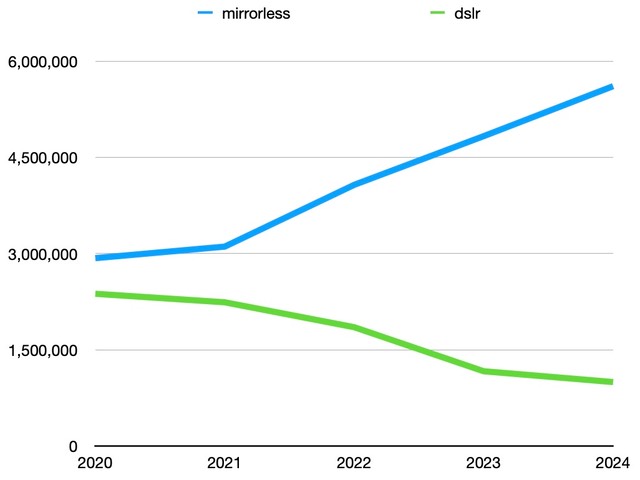News/Views
The CP+ Product Announcements (Updated Daily)

This page is a "living one" in that it will updated with new information as it becomes available. The latest products to be announced are at the top. Everything on this page was introduced prior to or at the CP+ trade show (February 27 to March 2), the largest photography show in Japan each year. (Should you understand Japanese, the online schedule of CP+ presentations is available here. OMDS and Sony have extensive online presentations planned. Nikon's presentations will be streamed via the Nikon CP+ site.)
Commentary on the below items is either in separate articles (e.g. OM-3) or at bottom of this page.
- Wrap-Up is on byThom
- Feb 27 — Just a note: a lot of these "displayed/announced" lenses don't yet have full details available. When they do, I'll add them to the relevant databases and update links. Particularly with the Asia lens makers, they tend to announce, later articulate details, and these don't get translated into English for a bit, as the Asian market is their primary target.
- Feb 27 — Sirui — three new Prime 1 cine lenses (RF, L, Z, FE)
- Feb 27 — DxO — PureRAW 5 announced (new noise reduction, better Fujifilm X-Trans support)
- Feb 27 — DxO — Photographer's Storm Cape (protective jacket for both photographer and gear)
- Feb 27 — Fujifilm — Maintenance firmware updates for X100VI, X-T5, X-T50, X-H2, X-H2S, X-M5, GFX100, GFX100S
- Feb 27 — Viltrox — 25mm f/1.7 Air (XF, Z, E), 35mm f/1.2 Lab (FE), 50mm f/2 (Z, FE), 85mm f/1.4 Pro (Z, FE)
- Feb 27 — Laowa — 35mm f/2.8 tilt/shift (RF, L, Z, FE, GFX, XCD), 15mm f/4.5 (RF, L, Z, E), 8-15mm f/2.8 fisheye (RF, L, Z, E), plus some cinema lenses
- Feb 27 — 7Artisans — 24mm f/1.8 (L, Z, FE), 35mm f/2.8, 25mm f/1.8, 35mm f/1.8, 50mm f/1.8 (last three APS-C)
- Feb 27 — Samyang (Schneider/Kreuznach) — displayed a 14-24mm f/2.8 lens for Sony FE
- Feb 27 — Monster LA-FZ1 prototype — Nikon screw-drive lens mount adapter
- Show now open
- Feb 26 — Sony — 16mm f/1.8G, 400-800mm f/6.3-8.0G — two new significant lenses for FE mount
- Feb 26 — Nikon Z6III and Z8 — new firmware with significant video updates
- Feb 25 — Voigtlander — 75mm f/1.8 manual focus lens (FE mount) with bokeh control ring
- Feb 25 — Zeiss — 50mm f/1.4 and 85mm f/1.4 Otus ML manual focus lenses (RF, Z, FE mounts)
- Feb 25 — Panasonic — S1RII full frame camera (44mp)
- Feb 25 — Voigtlander — 28mm f/2, 35mm f/1.2, 40mm f/1.2, and 50mm f/1.2 for Leica M-mount
- Feb 24 — Sigma — BF camera, 16-300mm f/3.5-6.7 OS Contemporary lens, 300-600mm f/4 OS Sports lens, discontinuation of DSLR lens development
- Feb 24 — Thypoch 75mm f/1.4 lens — Another small manual focus lens for the Leica M-mount
- Feb 19 — Canon Powershot V1 — not mirrorless, but this vlogging oriented camera takes on some mirrorless models.
- Feb 18 — Nikon Zf firmware update to include Nikon Imaging Cloud — not out yet, but pre-announced.
- Feb 14 — Voigtlander 35mm f/3.5 lens — A new, small, light manual focus lens for the Leica VM mount.
- Feb 14 — Tokina 11-18mm f/2.8 lens — A return of an autofocus wide-angle zoom lens, for the Fujifilm XF mount.
- Feb 12 — Nikon 28-135mm f/4 PZ lens — Nikon's first full frame video-targeted lens is a mid-range power zoom.
- Feb 6 — OMDS OM-3 — A retro-styled camera based upon the OM-1 Mark II.
- Feb 6 — OMDS 17mm f/1.8 lens — A weatherproof and new branding update of the original Olympus 17mm f/1.8 lens.
- Feb 6 — OMDS 25mm f/1.8 lens — A weatherproof and new branding update of the original Olympus 25mm f/1.8 lens.
- Feb 6 — OMDS 100-400mm f/5-6.3 lens — A weatherproof and new branding update of the original Olympus 100-400mm f/5-6.3 lens.
- Feb 6 — Nikon 35mm f/1.2 S lens — This is the third lens in Nikon's fast f/1.2 pro series of prime lenses.
We're now in the week where most of the CP+ related announcements occur, so if you're interested in the rumors/leaks prior to the actual announcements for the show, here's some of what we're tracking:
- Meike — 35mm f/1.8 Pro (unknown mounts, probably Z, FE), 85mm f/1.8 Pro (XF)
- MonsterAdapter — Nikon F-mount to Z-mount adapter (LA-FZ1) with screwdriver motor support
- Viltrox — 25mm f/1.7 Air (XF, Z, E), 35mm f/1.2 Lab (FE), 50mm f/2 (Z, FE), 85mm f/1.4 Pro (Z, FE)
As these and other products get announced, we'll update the database pages elsewhere on this site and the bullet lists on this page.
Commentary: Wednesday produced two very different sets of announcements. First, Sony extended their lens set to 78 lenses by introducing the 16mm f/1.8G and 400-800mm f/6.3-8G optics. This extends the G prime series to its widest focal length so far, plus pushes Sony's telephoto offerings higher, finally offering an 800mm choice without teleconverter. Both are reasonably priced lenses—the telephoto zoom is US$2900—so are likely to prove so popular that we'll quickly get into backorder situations with both. I'd say if you want one for spring/summer, you'd better get in line now. Meanwhile, Nikon continued its "improvement via firmware" progression with updates for the Z6III and Z8 that mostly help them work with the 28-135mm f/4 power zoom lens Nikon introduced earlier in the month. The big thing to note, though, is that the Z6III's video quality has improved, as Nikon has addressed the noise jitter that many of us found as we boosted ISO values.
Tuesday started with Panasonic and Zeiss announcements. From Panasonic we get a new S1RII body, replete with a new 44.3mp image sensor and a handheld 177mp pixel-shift capability. But much of the action here seems to focus on the video specs of the camera, which include 8K/30P, 6.4K open gate, and a bunch of other nice touches for a hybrid camera (e.g. 32-bit float audio). At US$3300, this body is taking on Sony A7R Mark V's and Nikon Z8's. This site's exclusive advertise, B&H, has a panel introduction/discussion of the S1RII scheduled for noon (ET) if you want to know more.
Zeiss, meanwhile, has risen from a deep sleep to introduce two new Otus lenses, this time for Canon RF, Nikon Z, and Sony FE full frame mirrorless cameras. As before, the new 50mm f/1.4 and 85mm f/1.4 Otus lenses are manual focus, though with completely new optical designs, some slimming/lightening, and (only ;~) US$2500 and US$3000 prices respectively.
Monday kicked off with Sigma being the big announcement maker. Surprisingly, we got a new L-mount camera, the bf which I see as basically a re-imagining of the original fp, as it uses the same 24mp image sensor and tries to be a simple, small unit. The difference this time is that Sigma has definitely doubled down on the "simple." Minimal controls, only a USB-C port, no card slot (230GB internal memory). We did get a new autofocus system, which the fp really needed. The camera grew slightly in width and depth and added a touch of weight, but it's still absolutely on the "small" side. Suffice it to say that the Sigma camera engineers are still marching to a different Taiko beat.
On the lens side, the 16-300mm f/3.5-6.7 OS lens eclipses the Tamron 18-300mm as the largest zoom ratio APS-C mirrorless lens. Available in Canon RF, Fujifilm XF, L-mount, and Sony E mounts at US$700 in April even has near macro-level capabilities (1:2 at 70mm). Not that I particularly am interested in it myself, but I have to wonder why Sigma is now embracing Canon RF and avoiding Nikon Z. I also have a question: why are crop sensor lenses being introduced in the L-mount? No crop-sensor L-mount camera is currently being produced.
The best of Sigma's announcements from my viewpoint is the US$6000 300-600mm f/4 OS, available in L-mount and Sony FE-mount. This is a big, ambitious lens that is going to make a lot of Sony Alpha owners have to make some choices about how they want to cover the longer telephoto focal lengths (Sigma already has a 500mm f/5.6 OS lens for the FE-mount). Coupled with Sony's expected 400-800mm f/6.3-8G lens announcement later this week, Alpha owners are finally getting a wide variety of choices for telephoto work, something that Nikon has concentrated on in the Z-mount (coupled with Tamron) for awhile now.
The 2025 Winter Lens Olympics
Lenses from all nations—okay, two nations—seem to be lining up to make this month's CP+ show in Japan into a slugfest of lens product announcements.
We've already had a few show up early: Nikon 35mm f/1.2 S, and the three OM repackages. But I'm now tracking lens announcements from at least eight other companies that are basically targeted at CP+ buzz, and I'm not sure the two companies I just mentioned are fully done.
CIPA reported about a 10% increase in lens sales for 2024 over 2023 (which was a flat year). Add to that the unknown number of Chinese lenses that also got sold during the year, and it's possible that the overall attach rate hit 2x during the year. (Attach rate is the number of lenses sold per body sold.)
Meanwhile, Tamron just reported that they expect to finish their fiscal year with more than 29% revenue growth, and have upped the number of new lenses they expect to produce each year from the old five/year to double that at ten/year.
What's driving this lens surge? Probably this:

That's the CIPA unit volume for mirrorless bodies from the low it hit in 2020 (pandemic related) to the present. If you map DSLR body sales against that you get:

Mirrorless grabbed the primary market share for ILC in 2020—DSLR still had the majority of sales in 2019—and as many of these cameras are now going to people who either (a) didn't have a DSLR or (b) had a DSLR but need to build a new mirrorless system, we're seeing strong lens demand.
I'm not predicting that mirrorless will continue with that upward slope in terms of sales. At the point where DSLR sales near zero, I expect the ILC market—which would be almost all mirrorless—to plateau. Moreover, it's starting to be clear that people who buy bodies such as the Canon R1/R5, Nikon Z8/Z9, Sony A7R/A9/A1 are more difficult to get to upgrade. That same problem will likely hit the next generation of mid-level bodies, too (e.g. Canon R6III, Nikon Z6III, and Sony A7V users will prove tougher to upsell).
So enjoy the lens parade that's about to happen in Yokohama. It's going to be interesting to see the Japanese reaction to having more than a few Chinese lenses launched at a Japanese trade show.
The OM-3 Is Announced
OM Digital Solutions today announced the OM-3, a camera that takes the spot between the OM-1 and the OM-5. In essence, the OM-3 is mostly the OM-1 internals and capabilities inside a new gripless body, because, you know, retro. OMDS uses the word "timeless design" to suggest a style link to the past, and doesn't actually refer to function, so not exactly retro. There appears to be no significant new features or abilities, with the impression that it's OM-1 electronics in a new body. One difference that isn't getting mentioned is that the EVF has been downgraded to 2.36m dot (from 5.76), the eyepoint has increased, and that the OM-3 is not dual slot. I found a few other small differences from the OM-1 Mark II, as well, but mostly things that looked more like firmware updating than functional differences.
Again, the OM-3 is a camera slotted between between two existing ones, so that tends to restrict what is done, otherwise the new body might hurt sales of the existing ones. That said, if you can handle a flat front body, the OM-3 is pretty much an OM-1 at a lower price (US$2000 versus US$2400, though the OM-1 Mark II is currently on sale for...wait for it...US$2000).
Along with the OM-3, OMDS also announced redesigns of the 17mm f/1.8, 25mm f/1.8, and 100-400mm f/5-6.3 IS. These redesigns don't change the optics, but do add weather sealing in modern OM-clad housings.
________________
Commentary: Here's a puzzle: how do you create a "retro design" camera when your modern cameras are not all that removed from what you originally did?
When I first heard the rumors that OM Digital Solutions was going to make a retro camera, my first thought was "don't they already make those?" The OM-5 in panda cladding looks an awful lot like an old film SLR. It's really just the back (screen and controls) that screams "digital," and I'm not sure how you avoid a screen and additional controls for a digital camera. (Yes, I know there are a couple of examples of that, but they don't strike me as fully usable, general purpose cameras.)
Interestingly, Olympus seems to be using the 1972 OM-1 film SLR as its target for aesthetic design. Too bad they missed the 50th anniversary ;~). Just saying you're doing "retro" is no longer really a big thing, and not much of a marketing message. OMDS made a big mistake in not doing using that 50th anniversary, where they could have built a fuller, more compelling story behind the marketing efforts. "It's the 53rd anniversary" doesn't have much of a ring to it, after all.
Yes, I'm a contrarian when it comes to so-called retro designs. I have been since the Nikon Df, and later Fujifilm and Nikon models. There's a reason why camera user interfaces modernized: you can control more, and do so more quickly. The so-called "dials interface" retro cameras, with dedicated ISO, shutter speed, and aperture dials, tend to force you to work more slowly, They also usually leave off all the step savers and shortcuts to the more complex interactions you'll need to make with the camera at some point.
Sure, three dials make the camera more simple in one aspect (exposure). But really, is that the thing you need so much control over these days? Dials are bit like a comfort blanket for those that learned how to photograph 50 years ago. To the young, they're a fad complication that will pass soon.
But the OM-3 doesn't even have those dials. Instead we have the more modern Mode dial, plus the digital Pen's front style "creative" dial. Moreover, the original film-based OM-1, while it did have dials, had two of them at the lens mount (shutter speed on the camera side of the mount, aperture on the lens side), which was itself a bit of a modernization (for smaller lenses with the camera held normally it moved the control of those two parameters to the fingers of the left hand without moving the hand).
In essence, OMDS is doing a strange thing with this new model, squeezing the current OM-1 innards into a changed and slightly simplified body and trying to wedge that between the OM-1 and OM-5. I'm not sure that there's room there for that. Moreover, the body that needs some love is the E-M10, which still hasn't had it's OMization. Still, perhaps the "newness" of the "timelessness" may trigger some additional buying by a few. I'm unconvinced as to why I'd want the OM-3 over the OM-1 Mark II, though.
Then there's this: in producing the OM-3 they've taken the hand grip off because, well, old film SLRs didn't have one and they're trying to make this look like a film SLR. Handgrips, even the modest one on the OM-5, are useful, though. So what we have OMDS doing here is removing or redesigning useful things just for looks.
Meanwhile, the three "new" lenses are really old optical designs in new housings, something they were committed to having to do in the process of moving from Olympus branding to OM branding.
It feels to me like Olympus got stuck in a museum with the OMDS transfer. The preservation efforts continue, but it doesn't seem like innovation is in the building any more. This marks the second year in a row we've gotten essentially a no update update.
